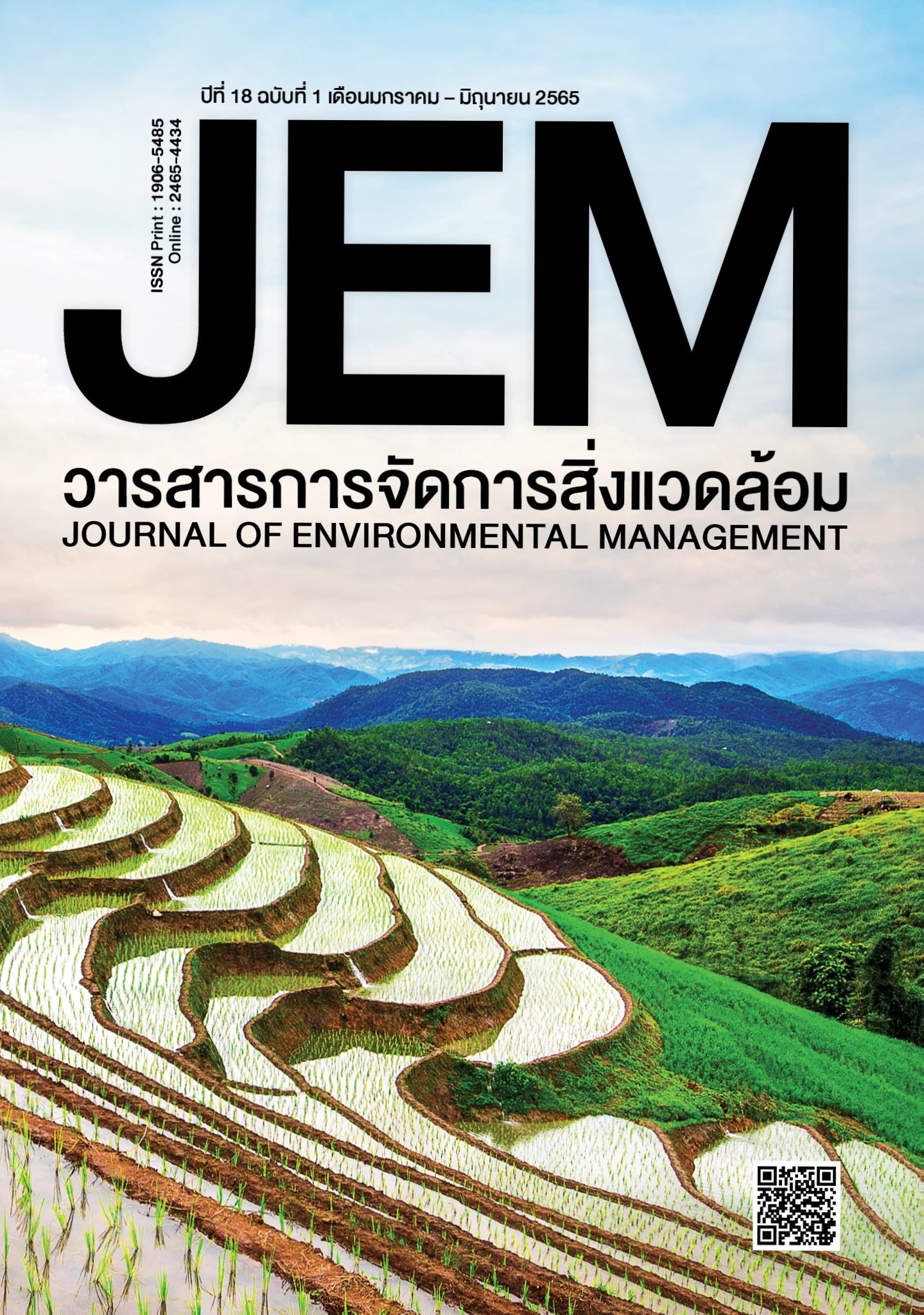RELATIONSHIP OF PARTICULATE MATTER RETRIEVED FROM SATELLITE AND GROUND MEASUREMENTS IN NORTHERN THAILAND
DOI:
https://doi.org/10.14456/jem.2022.5Keywords:
Aerosol optical depth (AOD), PM2.5, PM10, Satellite, VIIRSAbstract
Aerosol Optical Depth (AOD) data from the Suomi-NPP VIIRS satellite were analyzed for their relationship to particulate matter (PM), including particulate matter with diameter of less than 2.5 microns (PM2.5) and particulate matter with diameter of less than 10 microns (PM10) from the ground air quality monitoring station of the Pollution Control Department of Thailand. The study was divided into 2 parts. The first part was a comparison of extracting AOD data from 6 different area sizes. The analysis of the relationship between AOD-PM found that the area size 0.5ºx0.5º and 0.2ºx0.2º had the Correlation Coefficient (R) is the highest. The second part is the development of a model to predict the PM value by considering the meteorological factors such as Relative Humidity (RH), Temperature (T) and Wind speed (WS). It was found that Relative Humidity was the most important variable for predicting PM values. It analyzes the relationship between Estimated PM (predicted PM value with model equations) and Observed PM (actual measured PM). It was found that Estimated PM2.5 - Observed PM2.5 and Estimated PM10 - Observed PM10 had R values in the range of 0.47-0.81 and 0.62-0.81 respectively, with root mean squared error (RMSE) for predictions in the range of 13.60 - 55.43 µg. /m³ and 19.38 - 33.95 µg/m³ respectively
References
Benas, N., Beloconi, A., & Chrysoulakis, N. (2013). Estimation of urban PM10 concentration, based on MODIS and MERIS/AATSR synergistic observations. Atmospheric Environment, 79, 448-454.
Chantara, S., Wangkarn, S., Sangchan, W., & Rayanakorn, M. (2010). Spatial and temporal variations of ambient PM10-bound polycyclic aromatic hydrocarbons in Chiang Mai and Lamphun Provinces, Thailand. Desalination and Water Treatment, 19(1-3), 17-25.
Geo-Informatics and Space Technology Development Agency (Public Organization). (2020). Report on the situation of forest fires and smog from the satellite data for the year 2020 [In Thai]. Retrieved March 14, 2021, from https://fire.gistda.or.th/fire_report/Fire_2563.pdf.
Handschuh, J., Erbertseder, T., Schaap, M., & Baier, F. (2022). Estimating PM2.5 surface concentrations from AOD: A combination of SLSTR and MODIS. Remote Sensing Applications: Society and Environment, 26.
Jackson, J. M., Liu, H., Laszlo, I., Kondragunta, S., Remer, L. A., Huang, J., & Huang, H.-C. (2013). Suomi-NPP VIIRS aerosol algorithms and data products. Journal of Geophysical Research: Atmospheres, 118(22), 12,673- 612,689.
Kanabkaew, T. (2013). Prediction of Hourly Particulate Matter Concentrations in Chiangmai, Thailand Using MODIS Aerosol Optical Depth and Ground-Based Meteorological Data. EnvironmentAsia 6(2) 6(2), 65-70.
Karanasiou, A., Alastuey, A., Amato, F., Renzi, M., Stafoggia, M., Tobias, A., Querol, X. (2021). Short-term health effects from outdoor exposure to biomass burning emissions: A review. Sci Total Environ, 781, 146739.
Kerr, A.W., Hall, H.K., & Kozub, S.A. (2002). Doing Statistics with SPSS. Thousand Oaks: Sage Publications.
Khamkaew, C., Chantara, S., Janta, R., Pani, S. K., Prapamontol, T., Kawichai, S., Lin, N.-H. (2016). Investigation of Biomass Burning Chemical Components over Northern Southeast Asia during 7-SEAS/BASELInE 2014 Campaign. Aerosol and Air Quality Research, 16(11), 2655-2670.
Li, C., Hsu, N. C., & Tsay, S.-C. (2011). A study on the potential applications of satellite data in air quality monitoring and forecasting. Atmospheric Environment, 45(22), 3663-3675.
Moksony, F. (1990). Small is beautiful. The use and interpretation of R2 in social research. Szociológiai Szemle, Special issue, 130-138.
Mongkolphew, S. (2019). Assessment of the Relationship of Particulate Matter between Satellite and Ground based Measurements in Thailand. Unpublished Master’s thesis, Kasetsart University.
NASA. (2022). AERDT_L2_VIIRS_SNPP - VIIRS/SNPP Dark Target Aerosol L2 6-Min Swath 6 km. Retrieved March 4, 2021, from https://ladsweb.modaps.eosdis.nasa.gov/missions-and-measurements/products/AERDT_L2_VIIRS_SNPP.
Pollution Control Department. (2020). Plan to install air quality monitoring station Covering all over the country [In Thai]. Retrieved March 14, 2021
Punsompong, P., & Chantara, S. (2018). Identification of potential sources of PM10 pollution from biomass burning in northern Thailand using statistical analysis of trajectories. Atmospheric Pollution Research, 9(6), 1038-1051.
Suchit, P. (1994).environment and human settlement [In Thai]. Thai Junior Encyclopedia. Retrieved April 24, 2022, from https://www.saranukromthai.or.th/sub/book/book.php?book=18&chap=1&page=t18-1-infodetail05.html.
Wiratchai, N. (2010). Correlation analysis and regression analysis. published Master’s thesis, Sukhothai Thammathirat Open University.
Wiriya, W., Prapamontol, T., & Chantara, S. (2013). PM10-bound polycyclic aromatic hydrocarbons in Chiang Mai (Thailand): Seasonal variations, source identification, health risk assessment and their relationship to air-mass movement. Atmospheric Research, 124, 109-122.
Wu, J., Yao, F., Li, W., & Si, M. (2016). VIIRS-based remote sensing estimation of ground-level PM2.5 concentrations in Beijing–Tianjin–Hebei: A spatiotemporal statistical model. Remote Sensing of Environment, 184, 316-328.


